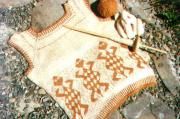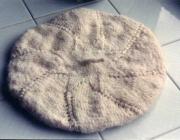The History of Knitting
THE HISTORY OF KNITTING
Knitting, as we know it, is not very old. Records indicate that the first sweaters were knit less than two centuries ago - in the 17th century. Before that time smaller pieces and undergarments were knit. The earliest, historical, example of true knitting is a pair of patterned cotton socks found in Egypt, dating back to A.D. 1100 - a mere 9 centuries ago. There may be knitted pieces found in India which were worked prior to that. Weaving and other textile arts date back to prehistory, so knitting is the textile infant.
Currently it is believed that knitting was first invented by Arabian nomads who carried the craft into Egypt. From there the craft was carried through North Africa and into Spain where it was picked up by traveling members of the Catholic church and spread rapidly throughout Europe.
Regardless of the origins of knitting, when it did catch on in Europe, it was quickly established as a true craft. During Medieval times professional guilds controlled the market, knitted garments came in fashion for the wealthy upper class, and knitting cottage industries sprang up throughout the country. Silk gloves and stockings were highly prized and intricate techniques perfected.
Different types of knitting have origins in diverse areas of Europe. Fair Isle knitting, a technique which uses two colors stranded into intricate patterns, originated on a group of islands north of Britain. The earliest museum examples of this technique are thought to have been knitted around 1850. This technique became popular when the Prince of Wales sported a Fair Isle sweater at a public event in 1921. Other legends attribute Fair Isle knitting to the year 1588 when a Spanish ship was wrecked off Fair Isle and the crew inspired the knitting natives to new forms of patterning colors.
Knitters in France created fashionable items prior to 1429. Many popular lace patterns in use today still have French names. Germany also has a long history of knitting. Much German knitting is worked on four or five needles in the round and stockings were quite popular there. This long-established craft is forever documented in the picture of the knitting Madonna, The Visit of the Angels, painted around 1390 by Master Bertram of Munich.
Fisher communities off the British coast are responsible for styles of Guernseys from the end of the eighteenth century onwards. These garments, often intricately patterned with textured stitches, were knit in the round and so tight they were water and wind proof. The designs were sometimes knit as a family "signature" piece so lost seamen could be identified from shipwreched remains.
As with other aspects of life, the industrial revolution took over the craft of knitting through the invention of the knitting machine. To compete with the speed of the new knitting frames many of the cottage industries started working piecemeal and garments began to be knit in flat pieces which were sewn together. Even with these speedy techniques hand knitting lost it's ability to compete in the marketplace with machines. Knitting as an art and a craft fell to the wayside and was kept alive only as a hobby.
In my opinion the real renaissance of knitting is happening today. Diverse techniques from different parts of the world are being combined into wonderful new techniques. Knitting, and other fiber arts, are just beginning to be accepted in art circles as pieces of worth. In the search for simpler ways to make life more meaningful knitting is reestablishing itself in people's everyday lives.



